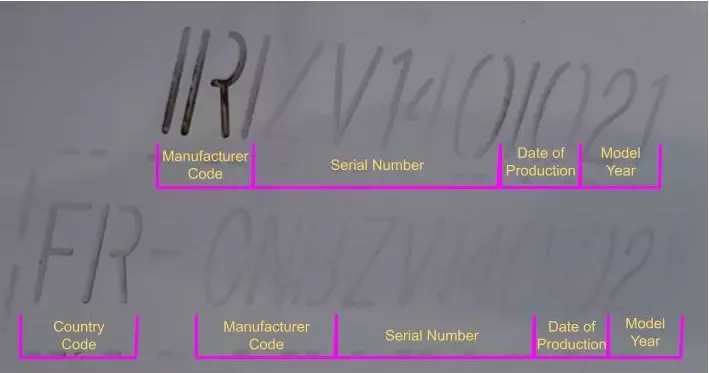Have you ever stumbled upon a string of letters and numbers on your boat and wondered, “What on Earth is this code?” Well, that, my friend, is not just a random sequence; it’s your boat’s Hull Identification Number (HIN). Think of it as your vessel’s DNA or social security number.
The Basics of Hull Identification Number
Definition and Background
The Hull Identification Number, commonly known as HIN, is a 12-character unique identifier given to boats. Established in 1972 by the US Coast Guard, it was introduced to aid in identifying vessels, especially in cases of theft or accidents. Just as vehicles have VINs (Vehicle Identification Numbers), boats have their own distinct ID, and that’s the HIN.
European Union Adoption
Recognising the need for standardised identification, like in the United States, the European Union adopted a similar system. This was in line with the Recreational Craft Directive (RCD), which came into effect in 1996. The RCD sets standards for the design and construction of recreational craft between 2.5 and 24 meters in length, including assigning a unique Hull Identification Number.
Why HIN Matters
At first glance, it might seem like just another set of numbers and letters, but the HIN carries weight. Firstly, it’s a legal requirement. All boats manufactured or imported into the US after November 1972 and those manufactured in the European Union after 1996 must have a HIN.
But beyond the legalities, the HIN serves practical purposes:
Verification – Whether buying a new boat or a pre-loved one, the HIN allows you to verify its identity. It ensures you’re getting what you paid for.
Registration – Boats must also be documented with local authorities, like car registration. The HIN plays a pivotal role in this process.
Safety – In the unfortunate event of a recall, manufacturers and authorities can track down boats with specific issues using the HIN. It ensures that boat owners can be traced so that necessary precautions can be taken.
In Europe, the HIN is not only a tool for identification but also an essential part of compliance with the Recreational Craft Directive. Manufacturers, importers, and distributors must ensure that boats meet specific safety, health, and environmental requirements, with the HIN serving as a critical identifier for these compliance checks.
International Collaboration
Adopting the HIN system in Europe has facilitated international collaboration and trade within the boating industry. A standardised identification system makes it easier for authorities and consumers to track and verify boats, regardless of their country of origin within the European Union.
Where to Find the Hull Identification Number
Manufacturing standards state that the HIN should be stamped or engraved into the hull on the starboard aft section close to the hull-to-deck joint. During my surveys, I’ve seen the hull number most often on the outer starboard hull just under the toerail, but I’ve also seen it on the cockpit coaming where it steps down to the aft swim platform, on the starboard side of the transom (as in the main photo above), and under the chart table.


What the Hull Number Looks Like
It can be challenging to find the hull number! Many production boat manufacturers use a stamping mechanism in the hull mould to leave a permanent imprint in the boat gel coat. This can get weathered with time and many years of hull polishing, so it’s barely decipherable. Use a graphite pencil to fill the indents to see the digits better. You may also find that the hull number has been engraved or stamped into a stainless steel or aluminium plate affixed to the hull in the starboard aft area or mounted in another location.

In a recent vessel survey, I found the hull identification number on the outside hull to starboard but also mounted on a metal plaque inside one of the bilges… presumably to foil thieves who might try to sand away the HIN in the primary location!
Deciphering the Hull Identification Number
The Structure of HIN
A Hull Identification Number might seem like a cryptic code at first glance. But once you understand its structure, it’s pretty straightforward. It’s composed of a 12 or 14 -character alphanumeric series, each part telling a story about the boat.

- Country Code: The HIN in Europe includes a two-letter country code that identifies the country where the boat was manufactured.
- Manufacturer Identification Code (MIC): The first three characters.
- Serial Number: The following five characters.
- Date of Production: Two characters that follow.
- Model Year: The last two characters.
Interpreting Each Part
Manufacturer Identification Code (MIC): This trio of letters and numbers is a unique identifier for the boat’s manufacturer. If you want to know who made the boat, this is the part to look at. The US Coast Guard maintains a MIC database that anyone can access.
Serial Number: Next in line are five characters that denote a unique set of digits particular to the boat. Think of it as the fingerprint for your boat. No two boats will share this sequence.
Date of Production: These two characters translate to the month and year of production. The first character signifies the month (A for January, B for February, and so on), and the second character denotes the last digit of the year.
Model Year: Lastly, the final two characters provide information about the specific model year of the boat.
In the example shown above, the boat was built in France (FR) by Chantier Navale de Bordeaux (CNB), it has a serial number of ZV140, produced in September of 2020 (letter I signifying the 9th month and number O signifying the year 2010), with a model year of 2021 (21).
Note that the manufacturer code in the USA is different from the one used in Europe.
Practical Applications of the HIN
Checking the HIN Before Purchase
If you’re eyeing a used boat, you must check the HIN. It gives you the boat’s identity, helps verify the information provided by the seller, and ensures that you’re making a legitimate purchase. Compare the hull number on the vessel with the one shown on the registration document to ensure you’re buying the boat listed on the papers.
Insurance and Registration
The HIN acts like your boat’s birth certificate regarding insurance and registration. It’s the primary identifier used by insurance companies and registration authorities.
The Role of HIN in Theft Recovery
The HIN is a powerful tool in the fight against boat theft. If a boat is stolen, the HIN can be utilised by authorities to track it down.. provided the thieves haven’t sanded it off!! Like a vehicle’s VIN, the HIN provides a unique identifier that’s difficult to alter or erase.
Common Mistakes and Misconceptions
Misreading the HIN
Reading the HIN can be tricky, especially for new boat owners. Common mistakes include confusing letters and numbers, like ‘I’ with ‘1’, or misinterpreting the production date.
Legal Misunderstandings
Some might assume that HIN is a mere formality, not realising its legal importance. It’s not just a boat’s identification; it’s a legal requirement. Lack of proper HIN can lead to serious legal ramifications, including fines and difficulty registering the vessel.
Some think the hull identification number reveals more information than it does, such as the boat’s value or previous owners. In truth, the HIN is about the boat’s identity, not its history. Always cross-reference the HIN with other sources of information for a complete picture of your boat’s background.
Tips for Boat Owners
Maintaining Your HIN
The HIN should be legible and intact. Inspect it for wear occasionally and take steps to protect it from weathering.
What to Do if the HIN is Damaged or Missing
If your HIN is damaged or missing, don’t panic. Document the damage, contact your boat registration authority, and follow their guidance to get it replaced. In all likelihood, they will ask you to get a stainless steel or aluminium plate made with the hull number engraved to be affixed in a protected location.
Resources for More Information
For more information, consult with:
– US Coast Guard’s MIC database
– Flag State authorities
– Professional boating organisations in your country
Conclusion
The Hull Identification Number is more than a string of characters. It’s a vessel’s identity, a legal marker, and a vital part of responsible boat ownership. From understanding its structure to knowing its practical applications and how to maintain it, this guide has hopefully given you a better understanding.
Now that you know where to look for it, take the time to check your boat’s HIN!
Have a question about the hull identification number? We welcome your comments and insights below.





